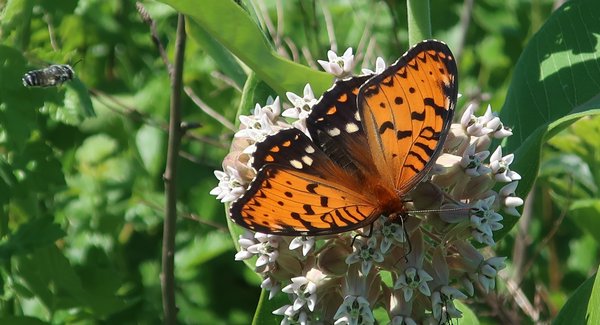The Fort Indiantown Gap military base in Lebanon County is home to the world's only surviving population of the eastern regal fritillary, a large butterfly that the U.S. Fish and Wildlife Service wants listed as an endangered species. The federal agency said the insect is facing extinction and more resources are needed to help establish habitats where new populations can thrive.
Once abundant throughout the eastern United States, the regal fritillary's numbers dwindled over the last century due to the loss of grassland habitats that offered protection and nourishment for the species throughout its life cycle. The related western regal fritillary is still found in 14 states in the Great Plains and Midwest, but the eastern butterfly has just one habitat at the National Guard installation about 100 miles west of Philadelphia.
MORE: Dominic Sessa to play celebrity chef Anthony Bourdain in 'Tony' biopic
For decades, the Pennsylvania National Guard and the Pennsylvania Department of Military and Veteran Affairs have partnered with biologists to preserve and manage the grassland habitat where the butterflies live on a section of the 18,000-acre base. Any hope of extending the butterfly's range to other locations depends on protecting their one stable environment.
"The ongoing effects of climate change and drought exacerbate threats to its rare habitat," the U.S. Fish and Wildlife Service said when it proposed listing the species earlier this month. "Changes in temperature and moisture could impact bloom times and the overall productivity of native violet species, which the eastern regal fritillary’s caterpillars need to survive."
When fully mature, the eastern regal fritillary is about the size of a monarch butterfly, with a wingspan between 2 1/2 and 4 inches. The species is distinguished from other butterflies by its mostly orange forewings and dark hindwings. Each year, they produce one generation in the late summer and early fall when females lay their eggs. The larvae spend the winter in grassland with tall vegetation, emerging in the spring as caterpillars that exclusively eat violets. The adult butterflies rely on nectar for food, sometimes traveling distances of up to 100 miles to find it.
Depletion of suitable grasslands in the regal fritillary's territory prevents new populations from taking hold in locations other than the carefully tended habit at Fort Indiantown Gap. Wildlife officials there do prescribed burns, conduct population surveys and aid captive rearing programs with zoos to keep the population growing and healthy. During the summer, the base holds guided tours of the eastern regal fritillary's habitat to educate the public.
Fort Indiantown Gap reached an agreement with U.S. Fish and Wildlife in February to formalize its commitment to preserve the species. They received a $1 million grant from the U.S. Army in May to work with Temple University researchers on implementing a long-term conservation plan The grant also will support the development of a program with the Pennsylvania Game Commission to establish a new population of the eastern regal fritillary.
There are more than 1,300 species listed as either endangered or threatened in the United States under the Endangered Species Act of 1973. When new species are added, they may receive more resources for conservation and are given protections from being killed, harmed or taken from their habitats.
The U.S. Fish and Wildlife Service also has proposed listing the western regal fritillary as a threatened species since it is not in immediate danger of extinction. A 60-day public comment period for proposed listings of both species will continue through Oct. 7

